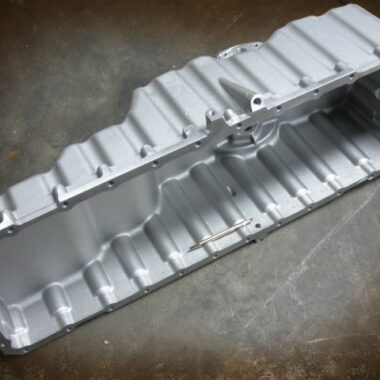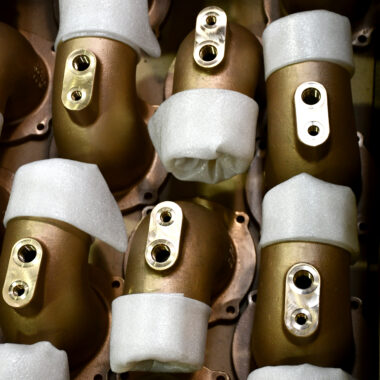Boost Your Craft: Advanced Techniques for Casting Aluminum Illinois
Boost Your Craft: Advanced Techniques for Casting Aluminum Illinois
Blog Article
Development in Aluminum Spreading: Cutting-Edge Techniques for Modern Creators
What really sets these innovations apart are the lasting light weight aluminum alloys being established and the high-pressure die spreading methods that are reinventing the industry. Join us as we explore the center of aluminum casting technology, where modern technology fulfills creative thinking to redefine what is possible in the globe of steel casting.

Advanced 3D Printing Techniques
Using sophisticated additive manufacturing processes, advanced 3D printing strategies have actually revolutionized the production of elaborate and tailored aluminum elements. By utilizing high-precision printers that can deal with light weight aluminum powders or filaments, manufacturers can create complex geometries and styles that were previously unattainable with standard manufacturing approaches.
Among the vital advantages of advanced 3D printing in light weight aluminum part manufacturing is the ability to achieve light-weight yet durable frameworks. This is specifically beneficial in sectors such as aerospace and auto, where weight decrease is critical for enhancing gas performance and total efficiency. Furthermore, the modification options offered by 3D printing allow for the manufacturing of one-of-a-kind and customized parts that meet specific requirements, resulting in enhanced functionality and efficiency.
In addition, the effectiveness of the 3D printing process minimizes product waste and minimizes the general production time, making it an affordable service for producing aluminum parts. As innovation continues to advancement, the capacities of 3D printing in light weight aluminum production are anticipated to broaden, providing also greater possibilities for technology in different industries.
Computer-Aided Style Developments
With the advancements in sophisticated 3D printing methods for aluminum parts, the combination of Computer-Aided Design (CAD) software application has come to be increasingly crucial in driving development and effectiveness in the manufacturing procedure. CAD innovations have actually revolutionized the method developers and engineers develop light weight aluminum casting molds by supplying accurate electronic modeling capabilities. These software application devices enable the development of intricate layouts and simulations that optimize the spreading procedure, resulting in higher top quality components.
One of the vital benefits of CAD in aluminum spreading is the capacity to discover possible issues early in the design stage, lowering expensive mistakes and revamp during production. By replicating the spreading procedure essentially, developers can analyze factors such as cooling down rates, product flow, and structural honesty before a physical mold is produced. This aggressive approach not only conserves time and resources but likewise makes sure that the last light weight aluminum components meet the desired specs.
Furthermore, CAD software allows quick versions and adjustments to styles, assisting in quick prototyping and modification to meet details needs. By leveraging CAD technologies in light weight aluminum spreading, suppliers can simplify their procedures, boost product quality, and remain at the center of technology in the sector.
High-Pressure Pass Away Casting Techniques
High-pressure die casting methods are widely identified for their effectiveness and precision in producing complex light weight aluminum elements. By using high pressure to require molten aluminum right into complex molds at rapid rates, this method permits the production of dimensionally precise and comprehensive components. Among the essential advantages of high-pressure die spreading is its capability to generate components with fine information and thin wall surfaces, making it optimal for applications where lightweight yet solid elements are necessary.
The procedure begins with the prep work of the die, which is generally made from hardened tool steel and includes two halves that create the preferred component shape. The molten aluminum is after that injected right into the die dental caries under high pressure, making certain that the material fills up all the detailed features of the mold. As soon as the aluminum solidifies, the die opens up, disclosing the finished part prepared for any kind of required post-processing.
High-pressure die spreading is typically made use of in numerous industries, including auto, aerospace, and electronics, where high-volume production of complicated aluminum elements is called for. casting aluminum illinois. Its ability to deliver tight resistances, superb surface finishes, and affordable manufacturing makes it a preferred option for modern-day makers intending to innovate in aluminum casting techniques
Sustainable Aluminum Alloys Growth

One approach to lasting light weight aluminum alloy advancement entails incorporating recycled aluminum material right into the alloy composition. By using recycled light weight aluminum, producers can lower energy usage and greenhouse gas exhausts connected with key aluminum production. In addition, recycling aluminum assists draw away waste from landfills, adding to a much more round economy.
Moreover, scientists are exploring new alloying aspects and handling strategies to boost the sustainability of aluminum alloys. By maximizing alloy compositions and producing procedures, it is feasible to boost the recyclability, resilience, and general environmental performance of aluminum items.

Automation and Robotics Integration
In the realm of lasting light weight aluminum alloys development, the assimilation of automation and robotics is changing producing processes, leading the way for increased performance and precision in manufacturing. Automation and robotics are enhancing conventional spreading techniques, supplying many advantages to designers in the aluminum market. By incorporating automation right into the spreading process, repetitive jobs that were once labor-intensive can now be successfully dealt with by robot systems, decreasing the threat of human error and boosting overall performance.
Automated systems can work all the time, making sure a continuous manufacturing cycle that decreases downtime and makes best use of output. Robotics combination allows for complex mold my site and mildews and detailed designs to be created with exceptional precision, meeting the demands of contemporary makers for top quality light weight aluminum parts. The use of automation in casting operations promotes a much safer working atmosphere by decreasing the exposure of workers to hazardous conditions.
Conclusion
Finally, the improvements in light weight aluminum spreading have actually changed the production industry. Advanced 3D printing Web Site techniques, computer-aided design innovations, high-pressure die casting methods, sustainable light weight aluminum alloys growth, and automation and robotics assimilation have all added to the innovation of the spreading process. These advanced methods have enabled creators to produce complex and high-quality aluminum products efficiently and successfully. The check out here future of light weight aluminum spreading is brilliant with continuous innovation and technical improvements.
What truly establishes these developments apart are the lasting aluminum alloys being created and the high-pressure die spreading techniques that are changing the market. Join us as we explore the center of aluminum spreading development, where modern technology fulfills creativity to redefine what is feasible in the world of steel casting.
One strategy to sustainable aluminum alloy growth includes integrating recycled light weight aluminum material right into the alloy structure - casting aluminum illinois. By making use of recycled aluminum, suppliers can decrease power consumption and greenhouse gas discharges connected with primary aluminum manufacturing. Advanced 3D printing techniques, computer-aided style innovations, high-pressure die casting approaches, sustainable aluminum alloys advancement, and automation and robotics assimilation have all contributed to the innovation of the spreading process
Report this page